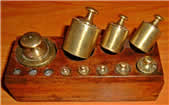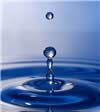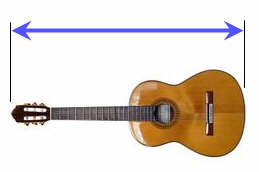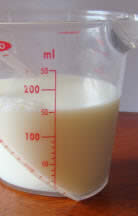LENGTH
You can measure how long things are, or how tall, or how far apart they are. Those are are all examples of length measurements.

Example: This fork is 20 centimeters long
These are the most common measurements:
|
Small units of length are called millimeters.
A millimeter is about the thickness of a plastic id card (or credit card). Or about the thickness of 10 sheets of paper on top of each other.
This is a very small measurement!
When you have 10 millimeters, it can be called a centimeter.
1 centimeter = 10 millimeters
A fingernail is about one centimeter wide.

Two tape measures, one in mm, the other in cm
The length of this guitar is about 1 meter
Meters might be used to measure the length of a house, or the size of a playground.
And because a centimeter is 10 millimeters: [1 meter = 1000 millimeters]
 A kilometer is equal to 1000 meters.
A kilometer is equal to 1000 meters.When you need to get from one place to another, you measure the distance using kilometers.
The distance from one city to another or how far a plane travels would be measured using kilometers.
Final thoughts about measuring length:
1 centimeter = 10 millimeters
1 meter = 100 centimeters
1 kilometer = 1000 meters
==========================================================================
MASS

Mass: how much matter is in an object.
We measure mass by weighing, but Weight and Mass are not really the same thing. These are the most common measurements:
|
Let’s take a few minutes and explore how heavy each of these are.
Grams
 |
A paperclip weighs about 1 gram. Hold one small paperclip in your hand. Does that weigh a lot? No! A gram is very light. That is why you often see things measured in hundreds of grams. |
A loaf of bread weighs about 700 g (for a nice sized loaf)
Kilograms
Once you have 1,000 grams, you have 1 kilogram.
1 kilogram = 1,000 grams
A dictionary has a mass of about one kilogram.
|
 |
 |
Kilograms are often written as kg (that is a "k" for "kilo" and a "g" for "gram), so "10 kg" means "10 kilograms". When you weigh yourself on a scale, you would use kilograms. An adult weighs about 70 kg. How much do you weigh? |
Tonne
Once you have 1,000 kilograms, you will have 1 tonne.
1 tonne = 1,000 kilograms
 |
Tonnes (also called Metric Tons) are used to measure things that are very heavy. Things like cars, trucks and large cargo boxes are weighed using the tonne. This car weighs about 2 tonnes. |
Final thoughts about measuring weight:
1 kilogram = 1,000 grams
1 tonne = 1,000 kilograms
==========================================================================
VOLUME OF LIQUID
These are the two most common measurements:
|
 A milliliter (that is "milli" and "liter" put together) is a very small amount of liquid.
A milliliter (that is "milli" and "liter" put together) is a very small amount of liquid.Here is a milliliter of milk in a teaspoon.
It doesn't even fill the teaspoon!
| If you collect about 20 drops of water, you will have 1 milliliter: |
20 drops of water  makes about 1 milliliter makes about 1 milliliter |
| And a teaspoon can hold about five milliliters: |
1 teaspoon of liquid  is about 5 milliliters is about 5 milliliters |
Here we have 150 ml of milk in a measuring cup.
It doesn't say "150" ... it says "50" ... but it is half-way between 100 and 200 so you can figure out it is 150 ml.

Liter
A liter is just a bunch of milliliters put all together. In fact, 1000 milliliters makes up 1 liter:
1 liter = 1,000 milliliters
This jug has exactly 1 liter of water in it.
Liters are often written as L (for short), so "3 L" means "3 Liters".Milk, soda and other drinks are often sold in liters.
The next time you are at the store take a minute and look on the labels to see how many liters (or milliliters) are in each container!
Liter is abbreviated L (some people use lowercase l, but that looks too much like 1). Another way of thinking about a liter is:
- A box that is 0.1 meters (10 cm) on each side,
- One square meter that is millimeter thick.
![*[ NOTA PENGAJARAN DAN PEMBELAJARAN ]*](https://blogger.googleusercontent.com/img/b/R29vZ2xl/AVvXsEiHxUHhLq34pRMpVRGwiF51pyvC7JJxHM4KP8Hd0-eys5qk5rcxSVddaZcsfy-aId0JdmPc3jv-cSpOIGYFhd63ImnzLHjMQMvzgMoZLw3ywNb7DyDlh0bX_KW-HsyU3dfbAtiQ4zygdxQ/s970/MATH+TEACHER+ONLINE+WITH+FRAME.jpg)




No comments:
Post a Comment